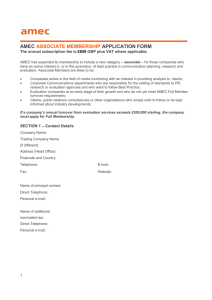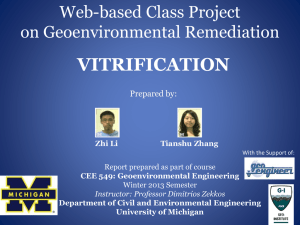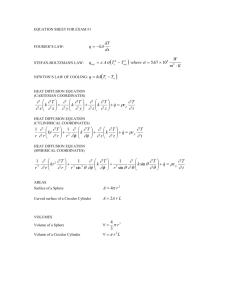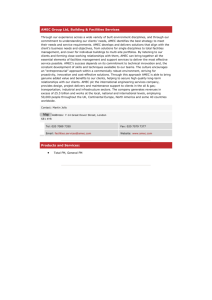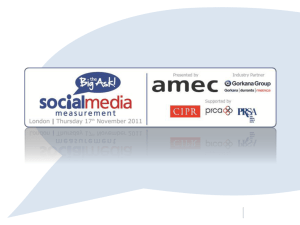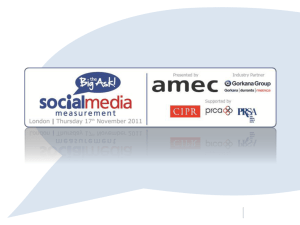WM’03 Conference, February 23-27, 2003, Tucson, AZ
advertisement
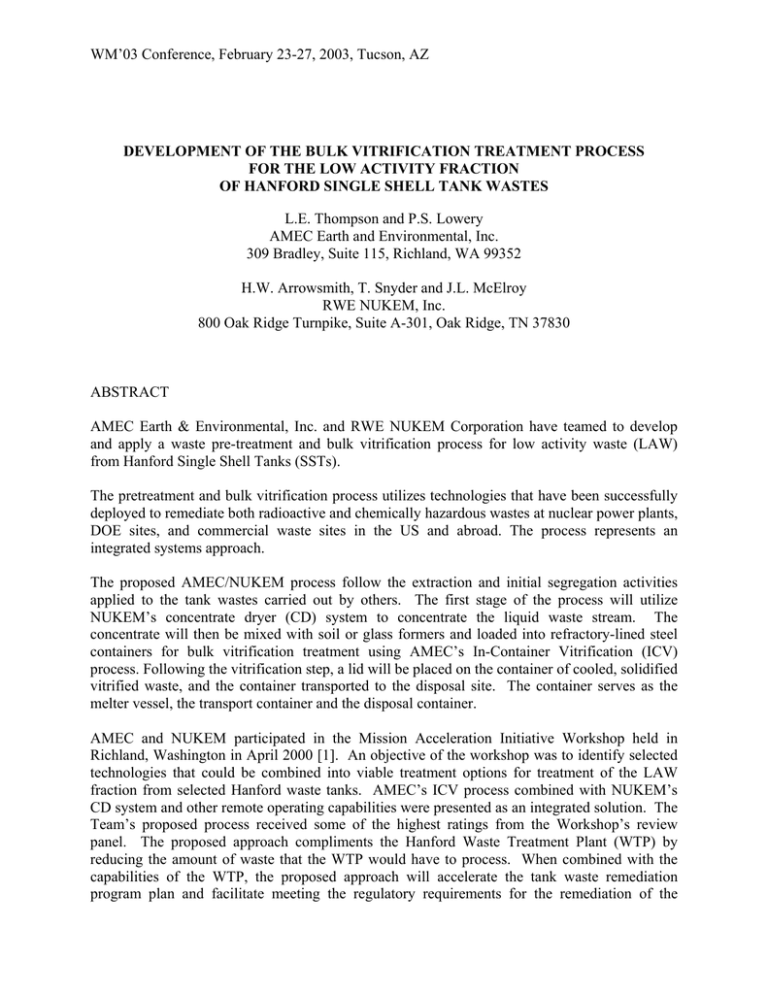
WM’03 Conference, February 23-27, 2003, Tucson, AZ DEVELOPMENT OF THE BULK VITRIFICATION TREATMENT PROCESS FOR THE LOW ACTIVITY FRACTION OF HANFORD SINGLE SHELL TANK WASTES L.E. Thompson and P.S. Lowery AMEC Earth and Environmental, Inc. 309 Bradley, Suite 115, Richland, WA 99352 H.W. Arrowsmith, T. Snyder and J.L. McElroy RWE NUKEM, Inc. 800 Oak Ridge Turnpike, Suite A-301, Oak Ridge, TN 37830 ABSTRACT AMEC Earth & Environmental, Inc. and RWE NUKEM Corporation have teamed to develop and apply a waste pre-treatment and bulk vitrification process for low activity waste (LAW) from Hanford Single Shell Tanks (SSTs). The pretreatment and bulk vitrification process utilizes technologies that have been successfully deployed to remediate both radioactive and chemically hazardous wastes at nuclear power plants, DOE sites, and commercial waste sites in the US and abroad. The process represents an integrated systems approach. The proposed AMEC/NUKEM process follow the extraction and initial segregation activities applied to the tank wastes carried out by others. The first stage of the process will utilize NUKEM’s concentrate dryer (CD) system to concentrate the liquid waste stream. The concentrate will then be mixed with soil or glass formers and loaded into refractory-lined steel containers for bulk vitrification treatment using AMEC’s In-Container Vitrification (ICV) process. Following the vitrification step, a lid will be placed on the container of cooled, solidified vitrified waste, and the container transported to the disposal site. The container serves as the melter vessel, the transport container and the disposal container. AMEC and NUKEM participated in the Mission Acceleration Initiative Workshop held in Richland, Washington in April 2000 [1]. An objective of the workshop was to identify selected technologies that could be combined into viable treatment options for treatment of the LAW fraction from selected Hanford waste tanks. AMEC’s ICV process combined with NUKEM’s CD system and other remote operating capabilities were presented as an integrated solution. The Team’s proposed process received some of the highest ratings from the Workshop’s review panel. The proposed approach compliments the Hanford Waste Treatment Plant (WTP) by reducing the amount of waste that the WTP would have to process. When combined with the capabilities of the WTP, the proposed approach will accelerate the tank waste remediation program plan and facilitate meeting the regulatory requirements for the remediation of the WM’03 Conference, February 23-27, 2003, Tucson, AZ Hanford tank wastes. Consequently, the DOE Office of River Protection and CH2MHill Hanford Group identified bulk vitrification as one of the technologies to be investigated in FY03 through a demonstration program [2]. In October 2002, CH2MHill issued a request for proposal for the process development testing, engineering and data package for a non-radioactive (cold) pilot bulk vitrification process, and pre-conceptual engineering of a production bulk vitrification system. With AMEC in the lead, AMEC and NUKEM responded with a proposal. Pacific Northwest National Laboratory (PNNL) will support the proposed project as a key subcontractor by providing equipment, facilities, and personnel to support small-scale testing, including the testing on samples of actual tank wastes. This paper will provide an overview of the pre-treatment and bulk vitrification process, summarize the technical benefits the approach offers, and describe the demonstration program that has been developed for the project. INTRODUCTION AMEC Earth and Environmental, Inc. (AMEC) has teamed with RWE NUKEM (NUKEM) to provide the Department of Energy’s (DOE) Office of River Protection (ORP) with a lower cost alternative approach to the vitrification of the low-level waste associated with the Hanford HLW Tanks, with emphasis on selected Single Shell Tanks (SSTs). The new, low cost approach is a combination of AMEC’s In-Container Vitrification (ICV) process and NUKEM’s waste drying/blending and nuclear technology capability. The combination of these technologies offers significant benefits to the Office of River Protection (ORP) and CH2M HILL Hanford Group. The pretreatment and bulk vitrification process utilizes technologies that have been successfully deployed to remediate both radioactive and chemically hazardous wastes at nuclear power plants, DOE sites, and commercial waste sites in the US and abroad. The process represents an integrated systems approach. The proposed AMEC/NUKEM treatment process follows the extraction and initial segregation activities applied to the tank wastes by others. The first stage of the proposed treatment process will utilize NUKEM’s concentrate dryer (CD) system to concentrate the liquid waste stream. The CD system utilizes a low temperature, vacuum based, high agitation, batch-drying approach. The concentrate will then be mixed with soil or glass formers and loaded into refractory-lined steel containers for bulk vitrification treatment using AMEC’s In-Container Vitrification (ICV) process. Following the vitrification step, a lid will be placed on the container of cooled, solidified vitrified waste and the container transported to the disposal site. The container serves as the melter vessel, the transport container and the disposal container, which simplifies the handling and disposal of the treated wastes. These features eliminate the requirements for dedicated melters, glass discharge systems, and precision glass frit addition systems. Consequently, the ICV process can readily accommodate a wide range of feedstock materials with fewer complications and constraints than can be achieved with conventional Joule-heated vitrification technologies. Key benefits include: WM’03 Conference, February 23-27, 2003, Tucson, AZ • Increased waste loadings (up to 50% higher) and a high quality product due to a higher concentration of glass formers • Reduced exposure and maintenance cost since minimal melter maintenance will be required • Fifty percent reduction in power required to melt one ton of LAW relative to conventional melters • Lower technical risk since ICV is derived from a base technology that has been used to process 20,000-MT of waste • Less expensive off-gas system because of significantly increased radionuclide retention efficiency (since the contamination is mixed and contained throughout in the glass forming materials and the melt/waste interface is on the sides and bottom of the melt pool rather than at the top surface in the plenum) • No anticipated problems processing wastes containing sulfates and substantial reduction of nitrates during the melting process. Unlike conventional melters that will require scale-up and sparging (bubblers) to achieve the desired treatment rates, ICV does not have to be scaled-up. The base vitrification technology that ICV is derived from has been routinely used to treat 100 tons of contaminated material per day. AMEC and NUKEM participated in the Mission Acceleration Initiative Workshop held in Richland, Washington in April 2000 [1]. An objective of the workshop was to identify selected technologies that could be combined into viable treatment options for treatment of the LAW fraction from selected Hanford HLW tanks. The bulk vitrification approach compliments the Hanford Waste Treatment Plant (WTP) by reducing the amount of waste that the WTP would have to process. When combined with the capabilities of the WTP, the proposed approach will accelerate the tank waste remediation program plan and facilitate meeting the regulatory requirements for the remediation of the Hanford tank wastes. The Team’s proposed process received some of the highest ratings from the Workshop’s review panel [1]. Consequently, the DOE Office of River Protection and CH2MHill Hanford Group identified bulk vitrification as one of the technologies to be investigated in FY03 through a demonstration program [2]. CH2MHill issued a request for proposal for the process development testing, engineering and data package for a non-radioactive (cold) pilot bulk vitrification process, and pre-conceptual engineering of a production bulk vitrification system. With AMEC in the lead, AMEC and NUKEM responded with a proposal. Pacific Northwest National Laboratory (PNNL) will support the proposed project as a key subcontractor by providing equipment, facilities, and personnel to support small-scale testing including the testing on samples of actual tank wastes. CONCENTRATE DRYER SYSTEM NUKEM has been providing liquid waste processing services to the commercial nuclear industry for many years. One of NUKEM’s waste pretreatment systems is its Concentrate-Dryer (CD). WM’03 Conference, February 23-27, 2003, Tucson, AZ The NUKEM CD utilizes a low temperature, vacuum based, high agitation, batch-drying approach to remove the water in liquid waste streams. This maximizes the volume reduction of water-based waste streams by reducing the waste to a dry product that represents the solids content of the feed stream. A photograph of a CD system is provided in Figure 1. Examples of waste streams the CD has been used to treat include: • Evaporator bottoms • Membrane concentrates • Sump and tank sludge • Non-dewaterable sludges • Filtrates and resins • Most water-based solutions. Fig. 1. Concentrate-Dryer system The CD used in the nuclear power industry will nominally process 1,000 gallons (CD-1000) and 600 gallons (CD-600) of concentrate slurry over a 24-hour cycle (based upon 15% boric acid slurry). Larger CD units include a CD-33000 that is capable of processing 5-gpm. The CD relieves the waste stream feed of virtually all of its water content by incorporating an advanced internal waste blending and agitation process that directs the waste continually toward the center of the dryer and transforms the waste into a uniform granular form. The first phase of the internal drying process brings the waste to a stage where large multi-sized “dough balls” have been formed. The next phase then break up these “dough balls” into small granular shapes that increase the waste surface area thereby promoting faster drying. The waste product generated by CD can be in either one of two different physical conditions - granular form or salt block waste form. WM’03 Conference, February 23-27, 2003, Tucson, AZ To assure safe operation, the dryer steam jacket is ASME Section VIII code stamped. It has a unique patented, agitating system that dries the waste material by atomizing and individualizing the solid waste particles. This is accomplished by forcing the waste into a three dimensional motion. The efficiency of the heat transfer as a function of product motion is optimized and exhibits heat transfer coefficients two to three times higher than those of a paddle or ribbon dryer. The dried waste product produced by the CD is routed through a gravity flow mechanism, which deposits the waste into the intended waste storage containers or disposal liner. For this application, the concentrated liquid waste stream will be introduced into a mixer where it will be mixed with soil and/or other glass formers. Following this step, the soil and waste mixture will be deposited in the ICV container. The CD is comprised of the six modularized components listed below. System components are manufactured in various skid mounted modular sections for ease of movement and placement. For ALARA considerations, many of the components, such as the control panel, vacuum skid, chill water skid, and steam generator skid, can be remotely located to accommodate low background radiation areas. The six modules are: Control Panel, Dryer Unit, Steam Generator, Vacuum Skid, Chill Water System, and Transfer Cart. For ALARA purposes, the unit internals are viewed by use of a lighted port, closed circuit TV, which is viewed at the system control panel. In addition, the unit is equipped with removable access doors on the outer shield to allow for easy access to vital system components. Easy access is an important feature as it allows for quick access to perform maintenance, upkeep and troubleshooting without having to remove all of the shielding or disassemble the unit. The CD unit meets REGUIDE 1.143 and the requirements established in ANSI/ANS-40.37-1993 entitled “Standard for Low-Level Radioactive Waste Processing Systems”. Components designed for wetted areas are constructed of stainless steel, while painted carbon steel is used for the unit’s structural support areas. IN-CONTAINER VITRIFICATION PROCESS AMEC developed the In-Container Vitrification (ICV) process for waste treatment applications. ICV involves the electric batch melting of contaminated soils, wastes and debris to result in the destruction, removal or permanent immobilization of hazardous and radioactive contaminants. An ICV melt container is illustrated in Figure 2. ICV has been used in Australia and Japan, and is being developed by AMEC for application in the US [3]. The batch technique involves staging and treating wastes in refractory-lined steel containers, such as B-25 boxes or roll-off boxes. After each batch of waste is treated, the melted waste is allowed to cool and solidify in the container. The vitrified treated waste can then be removed from the container for disposal and the container reused. Alternatively, the container and the vitrified waste can be disposed of after each melt. WM’03 Conference, February 23-27, 2003, Tucson, AZ Fig. 2. Illustration of ICV melt processing in a roll-off box. ICV works by directing electrical power to the treatment zone via graphite electrodes installed in the melt container. The ICV process uses Joule heat dissipated by passage of electric current through the soil/waste matrix to raise the temperature of the matrix to levels above the melting point of the materials contained therein. ICV requires soil or glass formers to establish the melt and create a stable, vitrified waste form. ICV can process other waste materials but soil or soil-like materials must be a major constituent of the materials being processed or soil must be added to the waste materials. Most soils consist primarily of silica and alumina, which are the glass formers for the process. Soil is not electrically conductive at ambient temperature. Therefore, the melting process is established by placement of a conductive pathway between the electrodes for passage of electrical current. The Joule heat generated in this pathway heats-up the soil surrounding the path to the point where it becomes molten. Most melts have a temperature of between 1400 to 1800°C. The melt temperature is determined by the chemical make-up of the soil and waste materials being processed. Once in this molten state, the mass becomes electrically conductive and can support current flow throughout the molten media. With continued application of electrical energy to the electrodes, this molten mass grows outward and downward out to the refractory liner within the melt container. The melt is constrained within the refractory liner. Because ICV is a batch process and the containers are either used only once and disposed of or are emptied and restaged after each batch (a new liner installed), the liner system is highly reliable as it is not degraded from sustained, long-term use. WM’03 Conference, February 23-27, 2003, Tucson, AZ The electrodes are allowed to gravity-feed into the developing melt, thereby insuring widespread distribution of current through the molten mass. For most container configurations, the melting process for each batch occurs over a two to three day period on an around the clock basis. The equipment can be configured to use two or four electrodes per melt container. If two electrodes per melt container are used, two batches can be processed in parallel. Organic contaminants contained in the soil/waste matrix are either destroyed in place by pyrolysis or dechlorination reactions, or processed in the off-gas treatment system (OGTS) [4]. Typically 90 to 99.9% of the organic contaminants are destroyed directly by the developing melt pool. Any residual organics released from the treatment zone to the off-gas are collected and treated by the OGTS. The net destruction and removal efficiency (DRE) for the ICV process is typically greater than 99.9999% for organic compounds [3, 4]. No organic contaminants remain in the vitrified product because of the inability of such compounds to exist in such an extremely hot environment for sustained periods (hours to days). Non-volatile and semi-volatile inorganics are remediated with similar results. Most metals and radionuclides are retained in the melt, with typical retention efficiencies (REs) of four nine’s or better (i.e., 99.99%) for the non-volatile species. The residuals released to the off-gas stream are filtered and/or scrubbed from the off-gas. Secondary wastes such as spent filters and used protective clothing that are generated as a result of ICV operations can be dealt with by adding them to subsequent batches of waste. The ICV process has been used successfully to treat wastes such as spent filters and used protective clothing. The ability of the ICV process to treat its own secondary wastes is a significant benefit because it minimizes the amount of wastes requiring other treatment or disposal. When the waste volume has been fully treated, electrical power is turned off and the melt pool allowed to cool and solidify. The vitrified product normally consists of a mixture of glass and crystalline materials and often has an appearance similar to volcanic obsidian. The composition of the vitrified product is relatively uniform even for cases when melting heterogeneous wastes. The relative uniformity is due to convective mixing currents that exist in Joule-heated melts. For most applications, the vitrified product is typically five to ten times stronger than un-reinforced concrete and is extremely leach resistant. The durability and leach resistance of the glass is due to a high concentration (up to 90 weight %) of glass formers (SiO2 and Al2O3) for contaminated soil applications. The vitrified product readily satisfies the requirements of the US Environmental Protection Agency’s (EPA) Toxicity Characteristic Leaching Procedure (TCLP). For contaminated soil applications, the vitrified product is normally 10 to 100 times more durable and leach resistant than typical borosilicate glasses used to immobilize high-level nuclear waste. The vitrified waste will be effectively inert and will surpass the most stringent of waste acceptance criteria. PROPOSED PROGRAM The proposed program involves a three-task approach. Task 1 will include: WM’03 Conference, February 23-27, 2003, Tucson, AZ • Process development testing at laboratory, engineering-scale and (optionally) demonstrations at or near production-scale • Waste form validation tests using simulant and radioactive samples • Engineering-scale simulant demonstrations to provide prototypical process results that will demonstrate that the key process operational and product quality requirements for processing the LAW can be attained • Radioactive engineering-scale tracer demonstrations to provide prototypical process results that will demonstrate that the key process operational and product quality requirements for processing the LAW can be attained. In the proposed program, PNNL will lead the development of glass formulations for the ICV process. Concentrated LAW and soil are intended to be the major constituents of the waste mixture. However, certain additives may be appropriate to optimize the performance of the vitrified waste form. The preferred formulation will then be tested at engineering-scale and optionally at or near production-scale. The resulting vitrified products will be evaluated using methods such as the Product Consistency Test (PCT), the Vapor Hydration Test (VHT) and the Toxicity Characteristic Leach Procedure (TCLP) test on both quenched and slow cooled glasses [5, 6]. Task 2 involves the preparation of an engineering data package for a cold pilot bulk vitrification process including associated materials handling processes. The cold pilot unit will be of appropriate form and capacity to facilitate engineering scale-up and modeling activities for the full-scale process. Task 3 involves the preparation of pre-conceptual engineering, and the production of preconceptual engineering documents in support of project definition, and pre-conceptual engineering and planning for the design of the production bulk vitrification system. The process development testing is designed to collect data that will establish the effectiveness of the ICV process and provide data to support the design work associated with Tasks 2 and 3. REFERENCES [1] Josephson, G.B., et al. 2002. Hanford Mission Acceleration Initiative – Draft Preliminary Testing Recommendations for Supplemental Treatment. PNNL-14005. August 2002. Pacific Northwest National Laboratory. Richland, WA 99352. [2] Recommendation for Supplemental Technologies for Potential Mission Acceleration. RPP 11261, Rev. 0. June 2002. CH2MHill Hanford Group, Inc. Richland, WA 99352. [3] Thompson, L.E. 2002. Batch Vitrification Treatment of Chlorinated Organic Wastes. Proceedings of the Twenty-First International Conference on Incineration and Thermal Treatment Technologies. New Orleans, Louisiana, USA. WM’03 Conference, February 23-27, 2003, Tucson, AZ [4] Thompson, L.E. 2002. Results and Reaction Mechanisms for the Treatment of Concentrated Chlorinated Organics Using GeoMelt Vitrification. Proceedings of the Third International Conference on Remediation of Chlorinated and Recalcitrant Compounds. Monterey, California, USA. [5] ASTM C 1285-02. Standard Test Methods for Determining Chemical Durability of Nuclear, Hazardous, and Mixed Waste Glasses: The Product Consistency Test (PCT). 2002 Annual Book of ASTM Standards, Volume 12.01. [6] Toxicity Characteristic Leach Test Procedure (TCLP), EPA SW-846, Method 1311.
